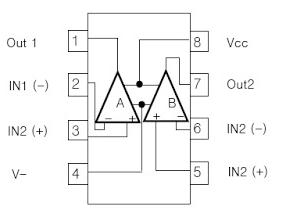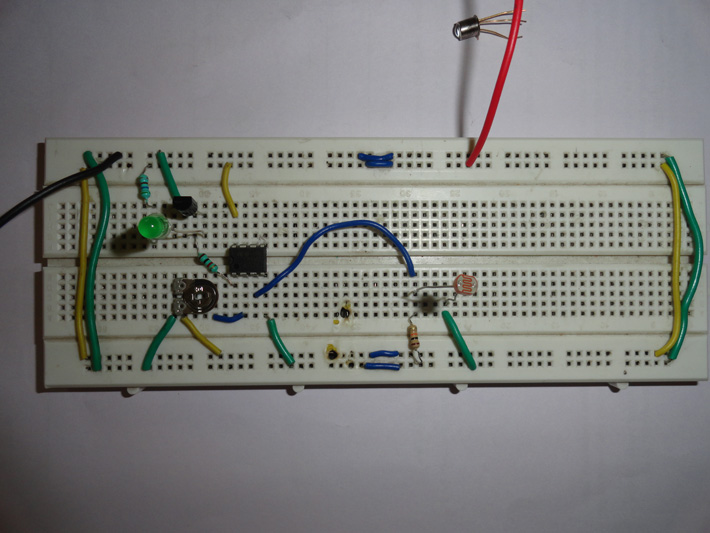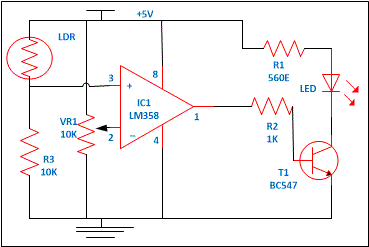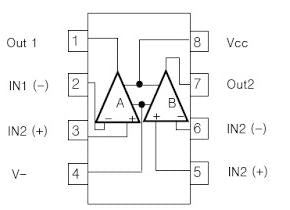In this project a circuit is made that can turn on the device when light falls on it . For this I will use the IC LM358 which is an operational amplifier. I made the circuit with LDR and a few other components. But when I replace the LDR with photodiode, phototransistor and transistor (L14F1) my circuit works fine without changing any other components. Before understanding the circuit I developed, let's first take a look at the components used in the circuit.
1. LM358 IC – The LM358 consists of two independent high-gain operational amplifiers in a single package. An important feature of this IC is that we do not require an independent power supply for the operation of each comparator on a wide range of power supplies. The LM358 can be used as a transducer amplifier, DC gain block, etc. It has a large DC voltage gain of 100dB. This IC can be operated on a wide range of power supplies from 3V to 32V for single power supply or from ±1.5V to ±16V for dual power supply and also supports large output voltage swing.
The pin configuration of the IC is shown below-

In the figure above you can see that the operational amplifier has two inputs and one output on an independent LM358. The inputs are on pins 2 (negative pin) and 3 (positive pin), the positive pin is used for positive feedback and the negative pin is used for negative feedback. Under ideal conditions, when no feedback is applied, the gain of the op amp should be infinite. When the voltage at pin 2 is greater than the voltage at pin 3, the output will increase towards the maximum positive voltage and a slight increase at the negative pin compared to the positive pin will decrease the output towards the maximum negative. This feature of op amp makes it suitable for level detection purposes.
2. LDR – LDR is a device whose sensitivity depends on the intensity of the light that falls on it. The resistance of the LDR decreases when the intensity of the light falling on it increases and vice versa (resistance increases when the intensity of the light falling on it decreases). In the dark or in the absence of light, the LDR has a resistance in the mega ohm range, which decreases to a few hundred ohms in the presence of strong light.
LDR Test
You can check the LDR with the help of a multimeter. Keep your multimeter in the region measuring ohms or resistors. When covering the LDR its resistance will be very high and when placing it in the light it decreases. This phenomenon indicates that the LDR is working properly. We are using this property of LDR to take action if your LDR is working correctly. A sensor, since a variable voltage drop can be obtained with varying light.
3. Photodiode – Photodiodes convert light into current or voltage depending on their mode of operation. It is a PN junction or PIN structure. When a photon with sufficient energy hits the diode, it creates a free electron and a hole. Now the holes move towards the anode and the electrons towards the cathode and a photocurrent is created.
Photodiode Test
You can check this with the help of a multimeter. Set your multimeter to the mV range. Now place the multimeter wire on the photodiode wires. Take the reading both in the dark and in the presence of light. It shows deflection in reading in light and dark (in dark the reading will be higher) than your photodiode is working well.
4. Phototransistor -The phototransistor is a light sensor similar to the basic transistor, but has a transparent cover. Phototransistors provide much better sensitivity than photodiode. The phototransistor has a larger base region than the collector compared to other transistor. They are made by the iron diffusion or implantation method. The phototransistor works in the active region. Generally its base is open to feel the light falling on it. When light falls on its base, the electron hole pair is generated. This phenomenon occurs mainly at the reverse-biased base collector junction, due to the movement of the electron hole pair of the electric field and supplying the base current, causing the electron to be injected into the emitter.
Phototransistor Test
You can check the phototransistor with the help of a multimeter. Set your multimeter in the resistance measurement region and place the multimeter leads at the collector and emitter. Now shine some light on the phototransistor and remove the light. You can see that the deflection in the multimeter reading in the light reading is small compared to the dark one. If this phenomenon is occurring, you can say that your phototransistor is fine. You can also use L14F1 transistor in place of phototransistor and the checking process is similar to how we check phototransistor.
It is always good practice to check components before using them.
Circuit application
– The circuit I made can be used as a dark sensor or light sensor with very few modifications. So you use it as security circuits like in intruder alarm , morning alarm , peephole , luggage alarm or it will turn on the light in darkness or turn off the light in the morning etc. according to your application.
– In the circuit diagram I used an LED to show the output. You can also use the relay in place of the LED to connect the doorbell or any external components such as lamp, buzzer, etc.
Circuit operation
The operation of the circuits is very simple, as we know that the LM358 compares the voltage applied to the input pin and provides the output. The voltage level we want to detect is applied to any of the input pins and the voltage to be detected is applied to the other pin. For dark sensor circuits, we apply voltage to the negative pin and the voltage to be detected is applied to the positive pin. Whenever the input voltage applied to the positive pin due to light falling on the LDR, the photodiode and phototransistor rises slightly above the voltage at the negative pin, the output suddenly rises to maximum positive and remains positive until the input voltage drops below the level to be detected. Transistor T1 is used to amplify the signals to drive the LED and resistor R1 is used as a current limiter to protect the LED and for the light sensor circuit, just the reverse of the above phenomenon is occurring. Just replace the LDR with photodiode and phototransistor and see that the circuit is working properly and the sensitivity of the circuit also increases. You can also connect different components and devices to the output, so try connecting your own device and see the output.

Circuit diagrams
| Try it with LM348 using LDR-2 |  |
| Circuit-2_0 |  |
(tagsToTranslate)lm358

